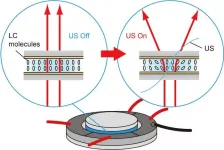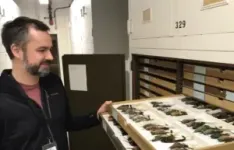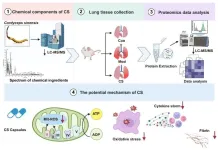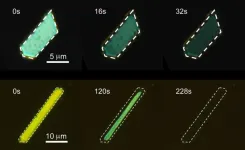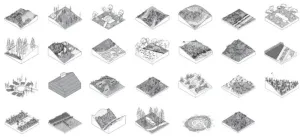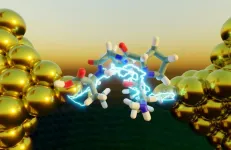Towards next-gen indoor lighting: novel tunable ultrasonic liquid crystal light diffuser
Researchers developed a novel tunable ultrasonic liquid crystal light diffuser that allows changing the diffusion direction
2024-07-26
(Press-News.org)
It is no mystery that light is essential to human life. Since the discovery of fire, humans have developed various artificial light sources, such as incandescent lamps, gaslights, discharge lamps, and light-emitting diodes (LEDs). The distribution and intensity of artificial lights indoors are important factors that affect our ability to study and work effectively and influence our physical and mental health. Consequently, modern artificial light sources are designed with these psychological elements to achieve the best aesthetics. LEDs, the most recent innovation in artificial light, have contributed to the development of environmentally friendly lighting systems due to their high efficiency. However, they tend to be smaller than traditional light sources, necessitating the use of diffusers to spread light over a larger area.
Conventional light diffusers have periodic surface profiles, periodic refractive index distributions, or light-scattering layers that direct and spread light in specific directions. The optical characteristics of these diffusers can be tailored during fabrication to meet specific requirements. However, once fabricated, these properties, including diffusion directivity, i.e. the direction of transmitted light distribution, cannot be changed. One method to control diffusion directivity after installation is to mechanically move the optical components, but this can increase the size of the device. Diffusers that enable control of diffusion directivity without using mechanical parts are rare.
In a new study, Professor Daisuke Koyama and graduate students, Mr. Yuma Kuroda and Mr. Ryoya Mizuno from the Faculty of Science and Engineering at Doshisha University, developed an innovative tunable ultrasonic liquid crystal (LC) light diffuser. Prof. Koyama explains, “Our ultrasonic LC light diffuser is based on the generation of non-coaxial resonant flexural vibration, which controls the molecular orientation and refractive-index distribution of the LC layer, providing control over diffusion angle and direction. It has a thin and simple structure with no mechanical moving parts.” Their device was detailed in a study published in the journal Scientific Reports on July 04, 2024.
The ultrasonic LC diffuser consists of a nematic LC layer sandwiched between two glass discs, and an ultrasonic piezoelectric transducer. The electrodes of the transducer are distributed in a circular pattern within the diffuser. Applying a continuous reverse-phased sinusoidal signal to the transducer produces ultrasonic vibration on the glass discs. When the frequency of this vibration matches the resonant frequency of the LC light diffuser, non-coaxial resonant flexural or bending vibration modes are generated on the LC layer at various frequencies. This results in differences in the acoustic energy between the LC layers, glass discs, and the surrounding air, inducing an acoustic radiation force acting at the LC layer and glass disc boundary. This effect changes the molecular orientation of the LC layers, altering the transmitted light distribution. By changing the electrodes to which the input voltage is applied, the direction of the molecular orientation and therefore the diffusion directivity can be easily rotated.
The researchers investigated the diffusion characteristics of the device and found that the diffusion angle depends on the input voltage amplitude and is maximized at 16 V. Above this voltage amplitude, the diffused light can become unstable. Additionally, the transmitted light distribution depends on the polarization of incident light.
“Light diffusers that allow control over diffusion directivity can reduce energy consumption and enable users to tune the light distribution to their taste, resulting in better aesthetics Our device marks the first report of an ultrasonically controllable optical diffuser based on LC material, providing users control over diffusion directivity within a small space,” remarks Prof. Koyama.
Indeed, this innovative device has the potential to revolutionize indoor lighting, contributing to enhanced and tailored aesthetics through controllable light diffusion.
About Professor Daisuke Koyama from Doshisha University, Japan
Daisuke Koyama is currently a Professor at the Faculty of Science and Engineering at Doshisha University. He obtained his M.S. and Ph.D. degrees from Doshisha University in 2002 and 2005, respectively. He is currently a member of The Institute of Electronics, Information and Communication Engineers, The Japan Society of Applied Physics, IEEE, and the Acoustical Society of Japan. He is also a leading member of the Laboratory of Ultrasonic Electronics at Doshisha University. He has over 290 publications with over 1700 citations. His research interests include optical devices, applied measurement, and ultrasound.
Funding information
This work was partly supported by Japan Society for the Promotion of Science (22H01391) and Tateisi Science and Technology Foundation.
Media contact:
Organization for Research Initiatives & Development
Doshisha University
Kyotanabe, Kyoto 610-0394, JAPAN
E-mail:jt-ura@mail.doshisha.ac.jp
END
ELSE PRESS RELEASES FROM THIS DATE:
2024-07-26
A recent study from China has reported that Cordyceps sinensis (CS), a traditional Chinese medicinal fungus, can ameliorate idiopathic pulmonary fibrosis (IPF) in mice by inhibiting mitochondrion-mediated oxidative stress. The research, conducted by a team led by Huan Tang and Jigang Wang from the Institute of Chinese Materia Medica at the China Academy of Chinese Medical Sciences, was published in Wiley's MedComm-Future Medicine.
Idiopathic pulmonary fibrosis is a chronic and progressive lung disease characterized by a decline in lung function, ultimately leading to respiratory failure and a significantly reduced quality of life for patients. With a median ...
2024-07-26
A rose by any other name is a rose, but what of a crystal? Osaka Metropolitan University-led researchers have found that single crystals of four anthracene derivatives with different substituents react differently when irradiated with light, perhaps holding clues to how we can use such materials in functional ways.
Graduate student Sogo Kataoka, Dr. Daichi Kitagawa, a lecturer, and Professor Seiya Kobatake of the Graduate School of Engineering and colleagues compared the photoreactions of the single crystals when the entire anthracene crystal was irradiated with light.
For two ...
2024-07-26
Over the past few decades, many parts of the world have experienced record-breaking wildfire events—a trend that is, unfortunately, expected to rise. These extreme events not only result in mass evacuations, but also release greenhouse gases like carbon dioxide, pose risks to life, devastate buildings and essential infrastructure, and fundamentally disrupt and detrimentally transform native ecosystems. In response to the increased risk of catastrophic wildfires, many planning and site design practices have sought to protect the trends and status quo of land development. These measures strive to resist and, ...
2024-07-26
Using modern techniques, researchers have re-examined Johannes Kepler's half-forgotten sunspot drawings and revealed previously hidden information about the solar cycles before the grand solar minimum. By recreating the conditions of the great astronomer’s observations and applying Spörer's law in the light of modern statistics, an international collaborative group led by Nagoya University in Japan has measured the position of Kepler’s sunspot group, placing it at the tail-end of the solar cycle before the cycle that Thomas Harriot, Galileo Galilei, and other ...
2024-07-26
Fukuoka, Japan – Researchers from Kyushu University have identified a potential therapeutic target for the treatment of advanced multiple sclerosis (MS), a potentially disabling condition associated with the central nervous system. In their latest study, conducted using an experimental mouse model of MS, they explored the role of connexin 43 (Cx43), a protein involved in cellular communication and cardiac function, and examined whether targeting this protein with specific blockers could improve ...
2024-07-26
A new paper surveying advances in diabetes pathogenesis and treatment explores the complex factors contributing to the onset and progression of the disease, suggesting that an understanding of these dynamics is key to developing targeted interventions to reduce the risk of developing diabetes and managing its complications.
In a paper published July 25 in a special 50th anniversary issue of the peer-reviewed journal Cell, the authors surveyed hundreds of studies that have emerged over the years looking at the causes underpinning types 1 (T1D) and 2 (T2D) diabetes and new treatments for the disease. They examine the role that genes, environmental factors, and ...
2024-07-26
What puts the electronic pep in peptides? A folded structure, according to a new study in the Proceedings of the National Academy of Sciences.
Electron transport, the energy-generating process inside living cells that enables photosynthesis and respiration, is enhanced in peptides with a collapsed, folded structure. Interdisciplinary researchers at the Beckman Institute for Advanced Science and Technology combined single-molecule experiments, molecular dynamics simulations and quantum mechanics to validate their findings.
“This discovery provides a new understanding of how electrons flow through peptides ...
2024-07-26
BENTLEY UNIVERSITY
New research from the Center for Integration of Science and Industry at Bentley University shows that differences between the financial structures of large pharmaceutical producers and smaller, emerging biotechnology companies creates synergies that contribute to the pipeline of new, innovative products in response to reductions in drug prices anticipated under the Inflation Reduction Act (IRA). While large pharmaceutical producers would likely reduce R&D spending in response to lower product revenues, R&D in smaller biotechnology companies is not likely to decrease and could sustain both corporate profits and new product ...
2024-07-26
Some 65 million Americans now own firearms for protection—around 80% of the country’s estimated 81 million gun owners—suggest the results of a nationally representative survey carried out in 2023, and published online in the journal Injury Prevention.
This perceived need is changing the profile of gun owners, the findings indicate, with increasing numbers of women and those of minority ethnic backgrounds citing protection as the primary reason for owning a firearm.
In 2021, firearms caused the highest ...
2024-07-26
There’s more than a 10-fold difference in the rates of unintentional gun deaths across US states, with such incidents claiming more than 12,000 lives between 2001 and 2021, finds research published online in the journal Injury Prevention.
Poverty, rural residency, non-White ethnicity and firearms ownership are all associated with higher rates, the findings show.
Firearms kill over 130 Americans every day. Most of these deaths are intentional, but of the 48,830 firearm related deaths in 2021, 549 were unintentional, note the researchers. But it’s not clear if rates differ within and between states.
To explore this further, the researchers looked ...
LAST 30 PRESS RELEASES:
[Press-News.org] Towards next-gen indoor lighting: novel tunable ultrasonic liquid crystal light diffuser
Researchers developed a novel tunable ultrasonic liquid crystal light diffuser that allows changing the diffusion direction
